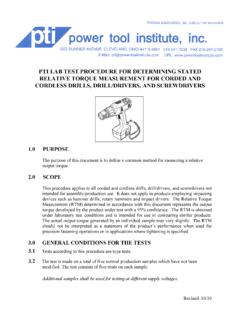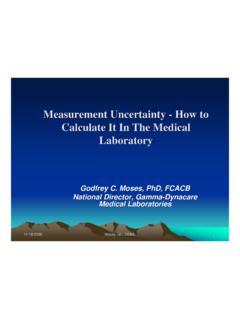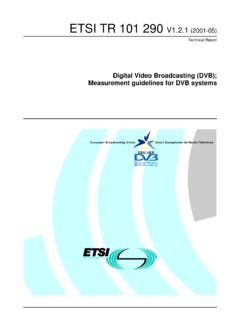Transcription of Speed-Power Performance of Ships during Trials and in Service
1 1 Speed-Power Performance of Ships during Trials and in Service Henk ( ) van den Boom 1), Ivo ( ) van der Hout 1) Maarten ( ) Flikkema 1) 1) MARIN, The Netherlands, Abstract Where in the past the operational cost of a ship was dominated by crew costs, this is now taken over by the bunker costs due to the ever increasing oil prices. To reduce operational costs, Ships should be optimised in fuel efficiency considering environmental conditions and operational parameters. As a first step the Speed-Power relation should be established by means of speed Trials upon delivery by the yard. A transparent and accurate industry standard for conducting and analys-ing speed Trials is discussed.
2 New methods to determine the added resistance of Ships in waves are presented and a consistent practice for speed Trials is proposed. The second step in optimizing the vessel Performance is to monitor the Speed-Power Performance of the vessel in Service . The vessel however is navigating under con-tinuously changing loading and environmental condi-tions. By a proper analysis of the results and a display to the crew, the in Service fuel consumption can be re-duced by optimum trim of the vessel, engine settings or timely cleaning of the propeller. Keywords Performance , Speed Trials , Added Resistance in Waves, Fuel Consumption 1. Introduction With increasing fuel costs and public attention to ex-haust gasses, optimizing ship Performance becomes a necessity to reduce operational costs and comply with emission restrictions.
3 Obviously the design of the hull lines and propeller and the engineering of the propulsion plant are key elements in ship Speed-Power perform-ance. To verify the actual Performance against the con-tractual requirements a speed trial is conducted upon delivery by the yard. To improve the transparency and reliability of speed trial results, MARIN in close cooperation with leading ship owners and major yards, cooperated in a Joint In-dustry Project regarding Sea Trials Analysis (STA-JIP). This project resulted in 2006 in a Recommended Prac-tice for Speed Trials and a Recommended Analysis of Speed Trials which are considered as industry stan-dards. ISO 19019 provides a standard method for performing speed Trials .
4 Previous so called standard analysis meth-ods as proposed by ISO 15016 and the recommenda-tions to the 22nd and 23rd ITTC by the Trials & Monitor-ing committee leave space for the engineer in charge of analysing speed Trials to choose different types of cor-rection methods. This makes it possible to make incor-rect choices and thus come to a different contract speed than the actual speed of the ship . This difference can be as high as several tenths of a knot. In the STA recom-mended practice, no choices can be made for different methods which make the accuracy of the method more reliable. Correction methods for environmental condi-tions are based on verified procedures and data sets.
5 The goal of the STA-JIP was to come to a transparent and accurate way of performing and analysing speed Trials . The aim was to determine the speed within knots which means that the accuracy of the power measurement has to be within 2%. The scope of the project was to perform case studies of speed Trials , de-velop a recommended practice and analysis for speed Trials and program the recommended practice into soft-ware (QSTAP) which can be used by STA participants. 2. Recommended Practice of Speed Trials In this section the recommended practice of how to perform a speed trial according to the STA-JIP is ex-plained. To perform a high quality speed trial measure-ment, which is the basis of a contractual agreement of ship speed, the following should be taken in to consid-eration: a The trial parameters that should be logged b The trial conditions that should not be exceeded during the trial c The procedures that should be followed during the trial d The contents of the trial report 2 In the ITTC recommended procedures extensive proce-dures are given for the preparation of a speed trial and the execution thereof.
6 The ISO procedure gives some guide-lines for the boundary conditions that should apply during the speed trial. Furthermore, the existing procedures often give a good guideline, but are not specific. The STA-JIP Practice combines the two latest standards and gives a transparent and practical overview of the minimum requirements that should be met in order to obtain reliable speed trial results. Trial Parameters The accuracy of the each measured parameter is the basis of the accuracy of the final trial speed. All the parameters should be recorded as accurately as possible. The primary measured parameters are shown in Table 1. Table 1: Primary parameters Parameter Measurement devices ship Track, Speed over ground DGPS Shaft Torque Torque sensor.
7 Shaft RPM RPM sensor Propeller pitch Bridge replicator Time GPS Time, Stopwatch Water depth ship echo sounder + nautical charts ship heading Gyro compass, or twin DGPS Relative wind ship anemometer, external anemometer Wave height & direction Wave measuring device ( radar, scanner. etc), Wave buoy, Hind cast, observation by multiple observers Draughts Physical observation and / or calibrated draught gauges The speed is to be measured by a global positioning system such as GPS. The GPS system should operate in the Differential mode to ensure sufficient accuracy; the speed should be measured within knots. The position and speed should be monitored and stored con-tinuously. The ocean current is determined and cor-rected for by performing forward and counter runs at equal power settings.
8 Shaft torque should be measured by means of strain gauges on the shaft for which the zero offset is deter-mined just prior to the trial. The measurement system should be certified for measurements on a test shaft with a bias error smaller than 1% so that an overall bias error of smaller than 2% (on board of the actual ship ) can be achieved. The ship s own sensor or an external wind meter can be used. The wind meter must be as clear as possible from the superstructure. In the analyses of the measurements the wind data from two consecutive runs at the same power level are combined to eliminate effects due to the Ships superstructure. Continuous recording of the wind during each run is recommended.
9 Preferably the wave height, wave period and direction of waves due to wind and swell should be determined using instruments. Use can be made of wave buoys or instruments onboard the Ships such as a wave radar and wave scanner. Although less accurate, wave observa-tions may also be determined from observations by multiple observers, including an experienced captain, supported by hind casting if the expected effect of the seaway is significant. Both hull and propeller are expected to be clean during the speed trial. It is the responsibility and benefit of the ship yard to make sure both are clean and smooth. Trial Conditions during the trial there are many conditions that deviate from the contract condition.
10 The objective during the trial is to keep the number of influencing factors as limited as possible. Correction methods to compensate for certain deviations from the contract condition are only valid up to certain limits. In order to arrive at reli-able speed trial results the boundary conditions should not exceed. The ship s displacement should be within 2% difference of the actual required displacement. If model test results are used for the analysis of the speed Trials , the dis-placement of the vessel during the Trials should be within 2% of the displacement used in the model tests for the trial draught. Trim shall be maintained within very narrow limits. For the even keel condition the trim shall be less than of the mid- Ships draught.







